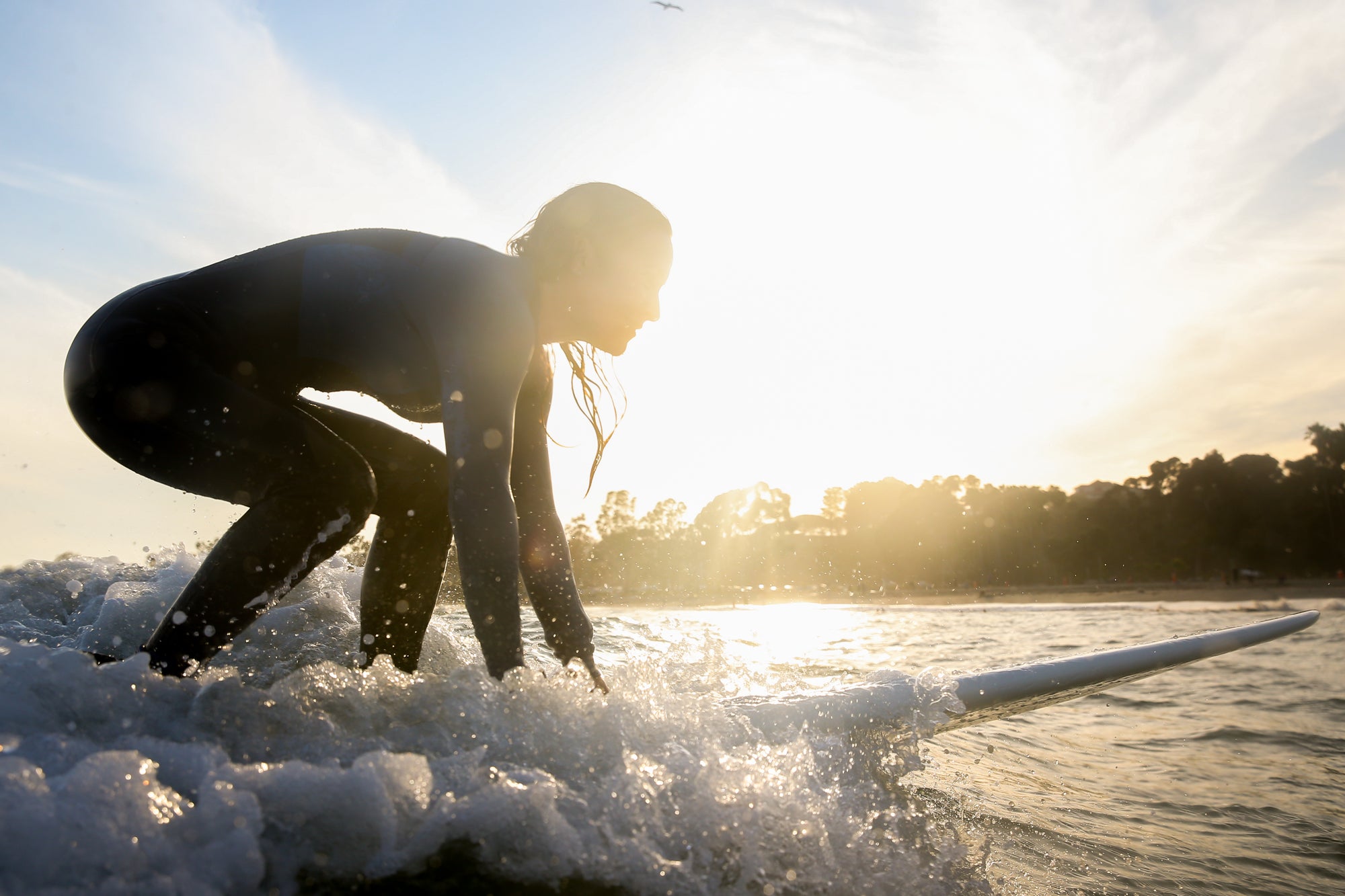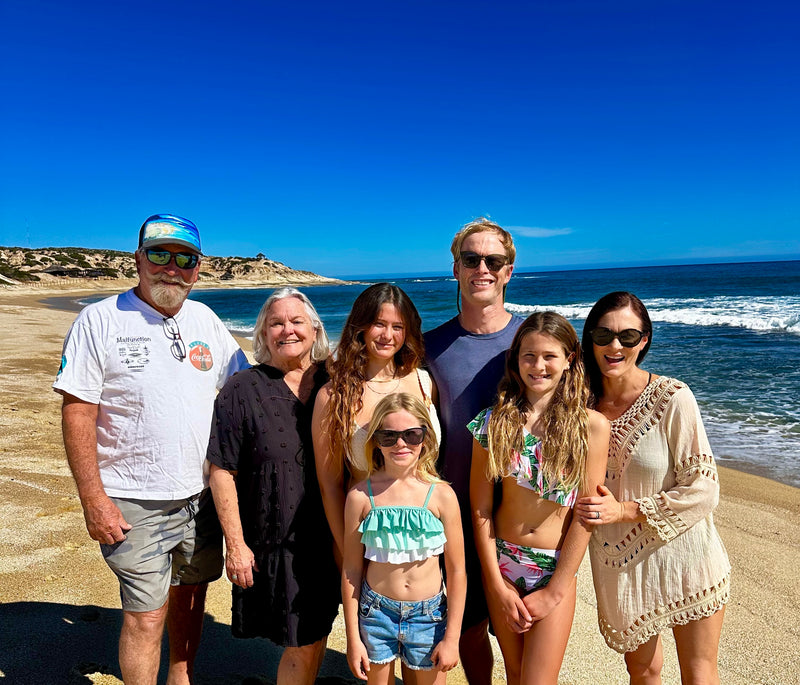9 Basic Tips for Beginner Surfers
•Posted on August 06 2019

Should you learn how to surf?
We believe that no matter who you are or where you’re from, the answer is yes—wholeheartedly yes.
Share in the stoke. Learn how to surf.
9 Beginner Surfer Tips
- Location is key
- Scout the waves
- Pick a landmark
- Wax your board
- Leash up
- The perfect (board) balance
- Don’t duck dive (yet)
- Practice makes the pop up perfect
- Tune into timing
As a beginner surfer, you should know that getting tossed is part of the game. But more importantly—surfing is fun. And second of all—it makes life better by improving your state of mind, connecting you with the beauty of nature & like-minded surf buddies, and inspiring treks across the globe to catch the next greatest wave.
There’s nothing like the thrill of sliding down the front of your first wave with just a board under your feet, but we wouldn’t tell you, as a beginner surfer, that it comes easy. Similar to riding a bike or playing guitar for the first time, learning how to surf can be a challenge and wipeouts are a part of the game—but we promise, every toss will be worth that first great wave.
As a beginner surfer, the pummeling can seem endless. But with time, effort, and consistency, the end is near! You’ll advance beyond beginner surfer to getting barreled, and we’re here to help. Once you’ve read up on surf etiquette, check out these beginner surfer tips, get stoked, and get started!
Surfing Basics
- Location is key

If you’re not sure where to find waves as a beginner surfer, ask around your local community. Pick a beach with easy, small, and rolling waves for more mellow rides. Here in SoCal, Doheny and San Onofre are beginner-friendly beaches.
- Scout the waves

If it’s firing, don’t go out! Scout the beaches—either online at surfline.com or do a driveby— for wave heights and conditions. Once you’ve chosen a beach with some laid-back vibes, watch the waves & time the sets from the sand to determine when to jump in. Charge in-between the sets of larger waves. If you’re unsure of timing, watch other surfers. Once you’ve made it in the water and past the break, look to see where the other surfers are positioned. Even when your surf skills are EPIC and advance beyond that of a beginner surfer, you’ll continue to watch the waves before jumping in for a session.
- Pick a landmark
It’s common for beginner surfers to drift—up, down, to the left, right, and upside down of the beach. It all depends on the current, so pick a landmark on the beach to help you stay even with where you want to be in the lineup. The best place to be is on the outside, where the waves are breaking, or on the inside shoulder (to the side). Line yourself up with the landmark and repeatedly check-in to make sure you’re in the right spot.
- Wax your board
To avoid more slips than necessary as a beginner surfer, wax your board before every session. A good wax job will be bumpy and give your feet some grip, which increases your chances of staying on both the board and the wave. A quick swipe of wax can make a massive difference. Check out this blog post for the full run-down on how to wax up like the pros.
- Leash up

No matter how cool those old-school, no-leash surfers might look, beginner surfers should always wear a leash. Leashes prevent your board from hitting other surfers, and allow you to catch more waves when you’re not always swimming after your board. Attach the leash to your back foot with the leash rope pointing outwards, away from your ankle. If the rope is pointing any other direction, your feet will likely get tangled and ultimately result in a bloopers-worthy fall.
- The perfect (board) balance
As a beginner surfer, you’ll need all the paddling power you can get—so choose a big board and keep it level and balanced, with the nose about an inch out of the water, for the maximum planing efficiency and speed. Your exact positioning and balance will depend on the rocker of your board, but if you need help—check out these rocker surf tips from Bill Stewart himself or come visit us at the shop.
- Don’t duck dive (yet)
For beginner surfers on a bigger board, duck diving isn’t the best tactic to get past breaking waves. Instead, try a turtle-roll—by grabbing the rails and flipping the board over so that you’re underneath, allowing the whitewater to pass over both you and the board. Or, stay on the board and push your body up and over the wave, letting the whitewater pass between your body and the deck of the board. Once you’ve mastered these skills and graduate to a smaller board—it’s time to learn how to duck dive! Check out Bill’s tips here.
- Practice makes the pop up perfect

If you’re trying to avoid looking like a beginner surfer, then you might not be stoked about this tip; but the truth is that we were all beginners, we’ve all been there, and practicing the pop-up before charging waves can be key. Place your beginner board on the sand, dig out a small hole for the fins, and lay down on your stomach with the tops of your feet pressed into the top of the board. Imitate a paddling movement with your head and chest raised. Imagine that the wave is beginning to lift you—in this moment, grip the sides of the board alongside your ribcage and push up. In the pushup, your torso will contract to swing your feet up and under your body, onto the board. In the swing, twist your hips so that your dominant foot swings to the front. As a beginner surfer, the movement can feel physically harsh, but you’ll get there. It’s all about becoming familiar with the feeling through practice.
- Tune into timing.

Timing is one of the gnarliest parts for beginner surfers. Once you’ve decided to take a wave, look back and keep an eye on it—start paddling to position yourself just to the left or right of where the wave is about to break. If you’re too far out, the wave will pass under you. If you’re too far on the inside, you may take a wave on the head. When the wave begins to reach its maximum height, is about to spill over, and barely begins to break, you’ll feel that moment when the wave starts to push your board and that’s when you’ll need to pop up—FAST. Through trial, error, and consistency, you’ll come to master timing and understand how it feels to catch a wave. Consistently watch the waves and tune in to how your positioning and timing played into whether or not you caught that wave.
Final Words
All of the best surfers were once beginner surfers—so you’re stoked and ready to go, right? If you’re feeling nervous or apprehensive about surfing, stop by or call the shop. We’ll answer your questions, work through your concerns, and can provide some rental gear if you need it.
And finally, when you move beyond beginner surfer, start cross-stepping, hang-five, and hang-ten with these tips from Bill Stewart himself. Keep us posted on your progress, we’d love to hear about it on social media! #stewart #featureme



